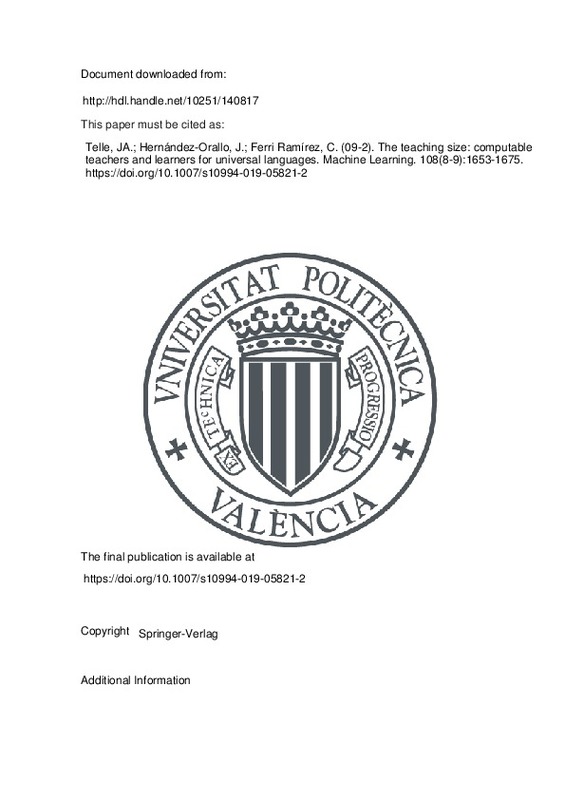Angluin, D., & Kriķis, M. (2003). Learning from different teachers. Machine Learning, 51(2), 137–163.
Balbach, F. J. (2007). Models for algorithmic teaching. Ph.D. thesis, University of Lübeck.
Balbach, F. J. (2008). Measuring teachability using variants of the teaching dimension. Theoretical Computer Science, 397(1–3), 94–113.
[+]
Angluin, D., & Kriķis, M. (2003). Learning from different teachers. Machine Learning, 51(2), 137–163.
Balbach, F. J. (2007). Models for algorithmic teaching. Ph.D. thesis, University of Lübeck.
Balbach, F. J. (2008). Measuring teachability using variants of the teaching dimension. Theoretical Computer Science, 397(1–3), 94–113.
Balbach, F. J., & Zeugmann, T. (2009). Recent developments in algorithmic teaching. In Intl conf on language and automata theory and applications (pp. 1–18). Springer.
Bengio, Y., Louradour, J., Collobert, R., & Weston, J. (2009). Curriculum learning. In Proceedings of the 26th annual international conference on machine learning (pp. 41–48). ACM.
Biran, O., & Cotton, C. (2017). Explanation and justification in machine learning: A survey. In IJCAI-17 Workshop on explainable AI (XAI) (p. 8).
Böhm, C. (1964). On a family of turing machines and the related programming language. ICC Bulletin, 3(3), 187–194.
Elias, P. (1975). Universal codeword sets and representations of the integers. IEEE Transactions on Information Theory, 21(2), 194–203.
Freivalds, R., Kinber, E. B., & Wiehagen, R. (1989). Inductive inference from good examples. In International workshop on analogical and inductive inference (pp. 1–17). Springer.
Freivalds, R., Kinber, E. B., & Wiehagen, R. (1993). On the power of inductive inference from good examples. Theoretical Computer Science, 110(1), 131–144.
Gao, Z., Ries, C., Simon, H. U., & Zilles, S. (2016). Preference-based teaching. In Conf. on learning theory (pp. 971–997).
Gold, E. M. (1967). Language identification in the limit. Information and Control, 10(5), 447–474.
Goldman, S. A., & Kearns, M. J. (1995). On the complexity of teaching. Journal of Computer and System Sciences, 50(1), 20–31.
Goldman, S. A., & Mathias, H. D. (1993). Teaching a smart learner. In Conf. on computational learning theory (pp. 67–76).
Gulwani, S., Hernández-Orallo, J., Kitzelmann, E., Muggleton, S. H., Schmid, U., & Zorn, B. (2015). Inductive programming meets the real world. Communications of the ACM, 58(11).
Hernandez-Orallo, J., & Telle, J. A. (2018). Finite biased teaching with infinite concept classes. arXiv preprint. arXiv:1804.07121 .
Jun, S. W. (2016). 50,000,000,000 instructions per second: Design and implementation of a 256-core brainfuck computer. Computer Science and AI Laboratory, MIT.
Khan, F., Mutlu, B., & Zhu, X. (2011). How do humans teach: On curriculum learning and teaching dimension. In Advances in neural information processing systems (pp. 1449–1457).
Lake, B., & Baroni, M. (2018). Generalization without systematicity: On the compositional skills of sequence-to-sequence recurrent networks. In ICML (pp. 2879–2888).
Lake, B. M., Salakhutdinov, R., & Tenenbaum, J. B. (2015). Human-level concept learning through probabilistic program induction. Science, 350(6266), 1332–1338.
Lázaro-Gredilla, M., Lin, D., Guntupalli, J. S., & George, D. (2019). Beyond imitation: Zero-shot task transfer on robots by learning concepts as cognitive programs. Science Robotics 4.
Levin, L. A. (1973). Universal Search Problems. Problems of Information Transmission, 9, 265–266.
Li, M., & Vitányi, P. (2008). An introduction to Kolmogorov complexity and its applications (3rd ed.). New York, NY: Springer.
Lieberman, H. (2001). Your wish is my command: Programming by example. San Francisco, CA: Morgan Kaufmann.
Shafto, P., Goodman, N. D., & Griffiths, T. L. (2014). A rational account of pedagogical reasoning: Teaching by, and learning from, examples. Cognitive Psychology, 71, 55–89.
Shinohara, A., & Miyano, S. (1991). Teachability in computational learning. New Generation Computing, 8(4), 337–347.
Simard, P. Y., Amershi, S., Chickering, D. M., Pelton, A. E., Ghorashi, S., Meek, C., Ramos, G., Suh, J., Verwey, J., & Wang, M., et al. (2017). Machine teaching: A new paradigm for building machine learning systems. arXiv preprint arXiv:1707.06742 .
Solomonoff, R. J. (1964). A formal theory of inductive inference. Part I. Information and Control, 7(1), 1–22.
Valiant, L. G. (1984). A theory of the learnable. Communications of the ACM, 27(11), 1134–1142.
Vapnik, V. N., & Chervonenkis, A. Y. (1971). On the uniform convergence of relative frequencies of events to their probabilities. Theory of Probability and Its Applications, 16, 264–280.
Zhu, X. (2013). Machine teaching for Bayesian learners in the exponential family. In Neural information processing systems 26, Curran (pp. 1905–1913).
Zhu, X. (2015). Machine teaching: An inverse problem to machine learning and an approach toward optimal education. In AAAI (pp. 4083–4087).
Zhu, X., Singla, A., Zilles, S., & Rafferty, A. N. (2018). An overview of machine teaching. arXiv preprint arXiv:1801.05927 .
[-]







![[Cerrado]](/themes/UPV/images/candado.png)


